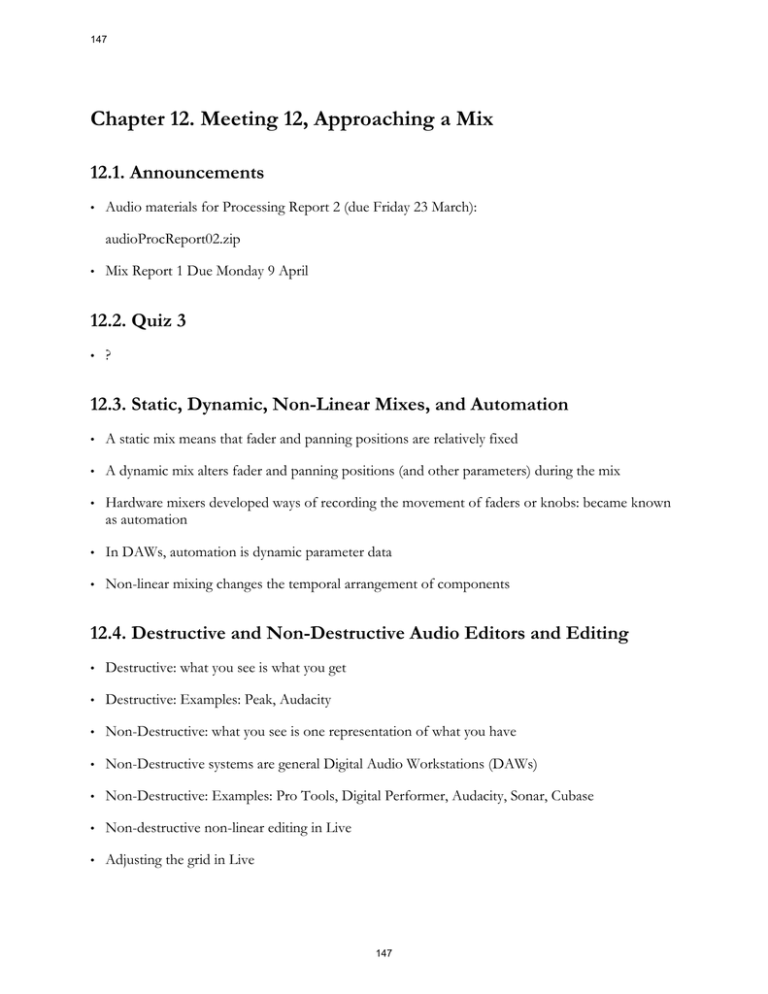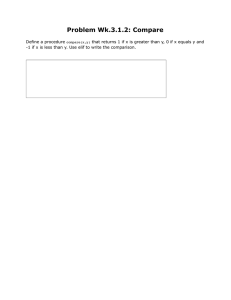
147
Chapter 12. Meeting 12, Approaching a Mix
12.1. Announcements
•
Audio materials for Processing Report 2 (due Friday 23 March):
audioProcReport02.zip
•
Mix Report 1 Due Monday 9 April
12.2. Quiz 3
•
?
12.3. Static, Dynamic, Non-Linear Mixes, and Automation
•
A static mix means that fader and panning positions are relatively fixed
•
A dynamic mix alters fader and panning positions (and other parameters) during the mix
•
Hardware mixers developed ways of recording the movement of faders or knobs: became known
as automation
•
In DAWs, automation is dynamic parameter data
•
Non-linear mixing changes the temporal arrangement of components
12.4. Destructive and Non-Destructive Audio Editors and Editing
•
Destructive: what you see is what you get
•
Destructive: Examples: Peak, Audacity
•
Non-Destructive: what you see is one representation of what you have
•
Non-Destructive systems are general Digital Audio Workstations (DAWs)
•
Non-Destructive: Examples: Pro Tools, Digital Performer, Audacity, Sonar, Cubase
•
Non-destructive non-linear editing in Live
•
Adjusting the grid in Live
147
148
12.5. Importing Audio
•
Non-Destructive editors provide representations of associated sound files and regions
•
Source audio files may or may not be in the project
•
Linking versus copying: always copy if possible
12.6. DAW Projects
•
Projects are a folder that contain many components
•
The project file is small: it only contains control and parameter information
•
The project contains subdirectories for audio files and other data
•
It is critical to keep all project components together
12.7. File Management in Live
•
Audio files in Live are not copied to the project unless explicitly forced to be
•
The File / Manage Files menu item shows a dialog to Collect Into Project
148
149
Courtesy of Ableton AG. Used with permission.
12.8. DAWs: Tracks
•
Many types: audio (mono, stereo, surround), MIDI, auxiliary, master
•
Input and output assignments may be busses or physical i/o
•
Tracks store information about audio files and how to play them back
•
Tracks store multiple parallel parameters that change over time
•
Managing automation data in Live
12.9. Master Tracks
•
Provides a final level control of mix
•
Will generally require 3 to 6 dB (or more) gain reduction below unity
•
May do 1 to 3 dB (no more) of limiting on master track is sometimes necessary
149
150
•
Do not compress or do other processing on the master track
•
Adding processing to the master track in Live
12.10. DAWs: Plugins
•
Plugins are serial (insert) processors
•
Each plug-in requires hardware processing power
•
Always conserve plug-in use as necessary
•
Using plug-ins for parallel processing requires an auxiliary track with an insert
12.11. Mixing Procedure
•
Be sure to time align tracks at beginning
•
Can crop tracks at beginning and end
•
Listen to each track alone and process
•
Apply channel strip processing
•
Apply fades to remove tacet portions, control start and end positions
•
Set basic pan positions
•
Mix groups of instruments organized by microphone capture, ensemble role, or other factors
•
Start with loudest instrument and mix downward
12.12. Channel Strip Processing
•
Optimize each channel or bus-group while maintaining gain staging
•
Use filters to isolate necessary frequencies
•
Use dynamic effects to remove leakage
•
Use moderate to deep compression to raise average level
•
Use shallow limiting to control extreme dynamics
150
151
12.13. Panning Stereo Sources
•
If coincident or near coincident, generally pan hard left and hard right
•
If not coincident, may explore mixture
•
Listen to mono mix to check for phasing distortion
•
If combining near and far captures, must pan close microphones to match distant stereo positions
12.14. Panning Mono Sources
•
Generally avoid 100% hard-panning (95% is a good maximum)
•
Low frequencies (bass, kick) are generally toward the center
•
Vocals are generally toward the center
•
Avoid center build-up with slight offsets out of center (+/- 5%)
•
Time keepers (high hat, ride, snare) are often off-center
•
Often similar musical roles are balanced left and right (guitars, keyboards)
•
Often aim for overall left-right balance
12.15. Levels
•
Generally 1 dB is the smallest amount of perceivable change
•
Always avoid channel, bus, or master clipping
•
Amplitudes are relative: find ways to cut rather than boost
•
May need to adjust levels by musical sections (boost for a solo)
12.16. Timing Offsets
•
Measuring distances and calculating millisecond offset
•
Use a delay plugin to push back closer microphones
•
Listen and adjust: perfect alignment is not required
151
152
12.17. Double Tracking
•
Using two copies of the same audio file panned hard left and hard right
•
Hard panning helps removing potential phasing problems
•
Delay a second copy by less than 30 ms
•
Delay processor must be at 100%
•
Alternatively, can use two similar takes of the same material
12.18. Bussing: Idiomatic to the DAW
•
DAWs can support huge numbes of buses
•
Bus design promotes sensible organization of tracks
•
Bus design promotes computational efficiency
12.19. Bussing: Multiple Captures of the Same Source
•
Group multiple microphones of the same source
•
Example: drum kits
•
Example: pianos
•
Example: guitars, amplifiers, direct signals
12.20. Bussing: Multiple Instruments Performing Related Roles
•
Grouping musical parts or sections
•
Example: rhythm sections
•
Example: background vocals
•
Example: multiple vocal parts
12.21. Mixing and Listening
•
Listen at multiple output volumes
•
Listen on multiple playback devices and headphones
152
153
•
Take breaks
12.22. Case Study: Mackie 1604 VLZ
•
One of the most popular small mixers
•
Complete manual in Blackboard course documents
•
Small collection of everything you need
© LOUD Technologies, Inc. All rights reserved. This content is excluded from our
Creative Commons license. For more information, see http://ocw.mit.edu/fairuse.
153
154
© LOUD Technologies, Inc. All rights reserved. This content is excluded from our
Creative Commons license. For more information, see http://ocw.mit.edu/fairuse.
154 MIT OpenCourseWare
http://ocw.mit.edu
21M.380 Music and Technology: Recording Techniques and Audio Production
Spring 2012
For information about citing these materials or our Terms of Use, visit: http://ocw.mit.edu/terms.




